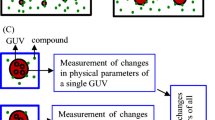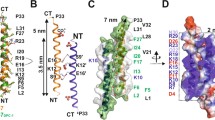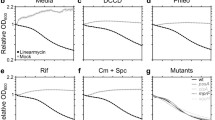Abstract
Membrane-interaction and assembly of a leucine zipper peptide (LZP), and its single (SASA) and double (DASA) alanine-substituted analog onto mammalian, hRBCs and 3T3 cells and bacteria, Escherichia coli and Staphylococcus aureus were studied as a model system to understand the plausible role of assembly on their contrasting cytotoxic but similar bactericidal activities. Peptides’ ability to depolarize and damage the membrane organization of hRBC and 3T3 cells decreased from LZP to SASA and to DASA which may be related to their decrease in assembly onto these mammalian live cells and oligomerization states in the presence of these cell membranes or zwitterionic PC/Chol lipid vesicles. However, LZP and its analogs showed appreciable similarities in damaging or depolarizing the E. coli or S. aureus cells, which further matched with their comparable assembly and oligomerization either onto these live cells or the cell membranes or in the presence of negatively charged PC/PG lipid vesicles.





Similar content being viewed by others
Abbreviations
- hRBCs:
-
Human red blood cells
- Fmoc:
-
N-(9-Fluorenyl) methoxycarbonyl
- Chol:
-
Cholesterol
- HPLC:
-
High performance liquid chromatography
- CFU:
-
Colony forming unit
- PC:
-
Egg phosphatidylcholine
- PG:
-
Egg phosphatidylglycerol
- NBD:
-
4-Fluoro-7-nitrobenz-2-oxa-1,3-diazole
- MALDI-TOF:
-
Matrix-assisted laser desorption ionization time-of-flight
- PBS:
-
Phosphate-buffered saline
- MICs:
-
Minimum inhibitory concentrations
- MTT:
-
3-(4,5-Dimethylthiazol-2-yl)-2,5-diphenyltetrazolium bromide
- FRET:
-
Fluorescence resonance energy transfer
- LUV:
-
Large unilamellar vesicles
- FITC:
-
Fluorescein isothiocyanate
References
Ahmad A, Yadav SP, Asthana N, Mitra K, Srivastava SP, Ghosh JK (2006) Utilization of an amphipathic leucine zipper sequence to design antibacterial peptides with simultaneous modulation of toxic activity against human red blood cells. J Biol Chem 281:22029–22038
Ahmad A, Asthana N, Azmi S, Srivastava RM, Pandey BK, Yadav V, Ghosh JK (2009a) Structure-function study of cathelicidin-derived bovine antimicrobial peptide BMAP-28: design of its cell-selective analogs by amino acid substitutions in the heptad repeat sequences. Biochim Biophys Acta 1788:2411–2420
Ahmad A, Azmi S, Srivastava RM, Srivastava S, Pandey BK, Saxena R, Bajpai VK, Ghosh JK (2009b) Design of nontoxic analogues of cathelicidin-derived bovine antimicrobial peptide BMAP-27: the role of leucine as well as phenylalanine zipper sequences in determining its toxicity. Biochemistry 48:10905–10917
Asthana N, Yadav SP, Ghosh JK (2004) Dissection of antibacterial and toxic activity of melittin: a leucine zipper motif plays a crucial role in determining its hemolytic activity but not antibacterial activity. J Biol Chem 279:55042–55050
Bilgicer B, Kumar K (2004) De novo design of defined helical bundles in membrane environments. Proc Natl Acad Sci USA 101:15324–15329
Boman HG (1995) Peptide antibiotics and their role in innate immunity. Annu Rev Immunol 13:61–92
Chen Y, Mant CT, Farmer SW, Hancock RE, Vasil ML, Hodges RS (2005) Rational design of alpha-helical antimicrobial peptides with enhanced activities and specificity/therapeutic index. J Biol Chem 280:12316–12329
Ghosh JK, Shaool D, Guillaud P, Ciceron L, Mazier D, Kustanovich I, Shai Y, Mor A (1997) Selective cytotoxicity of dermaseptin S3 toward intraerythrocytic Plasmodium falciparum and the underlying molecular basis. J Biol Chem 272:31609–31616
Giddings KS, Johnson AE, Tweten RK (2003) Redefining cholesterol’s role in the mechanism of the cholesterol-dependent cytolysins. Proc Natl Acad Sci USA 100:11315–11320
Glukhov E, Stark M, Burrows LL, Deber CM (2005) Basis for selectivity of cationic antimicrobial peptides for bacterial versus mammalian membranes. J Biol Chem 280:33960–33967
Hancock RE (1997) Peptide antibiotics. Lancet 349:418–422
Hancock RE, Sahl HG (2006) Antimicrobial and host-defense peptides as new anti-infective therapeutic strategies. Nat Biotechnol 24:1551–1557
Hawrani A, Howe RA, Walsh TR, Dempsey CE (2008) Origin of low mammalian cell toxicity in a class of highly active antimicrobial amphipathic helical peptides. J Biol Chem 283:18636–18645
Hilpert K, Volkmer-Engert R, Walter T, Hancock RE (2005) High-throughput generation of small antibacterial peptides with improved activity. Nat Biotechnol 23:1008–1012
Javadpour MM, Barkley MD (1997) Self-assembly of designed antimicrobial peptides in solution and micelles. Biochemistry 36:9540–9549
Lai Y, Gallo RL (2009) AMPed up immunity: how antimicrobial peptides have multiple roles in immune defense. Trends Immunol 30:131–141
Li WF, Ma GX, Zhou XX (2006) Apidaecin-type peptides: biodiversity, structure–function relationships and mode of action. Peptides 27:2350–2359
Liu LP, Deber CM (1998) Uncoupling hydrophobicity and helicity in transmembrane segments. Alpha-helical propensities of the amino acids in non-polar environments. J Biol Chem 273:23645–23648
Luo Z, Matthews AM, Weiss SR (1999) Amino acid substitutions within the leucine zipper domain of the murine coronavirus spike protein cause defects in oligomerization and the ability to induce cell-to-cell fusion. J Virol 73:8152–8159
Luque-Ortega JR, van’t Hof W, Veerman EC, Saugar JM, Rivas L (2008) Human antimicrobial peptide histatin 5 is a cell-penetrating peptide targeting mitochondrial ATP synthesis in Leishmania. FASEB J 22:1817–1828
Mahalka AK, Kinnunen PK (2009) Binding of amphipathic alpha-helical antimicrobial peptides to lipid membranes: lessons from temporins B and L. Biochim Biophys Acta 1788:1600–1609
Mani R, Cady SD, Tang M, Waring AJ, Lehrer RI, Hong M (2006) Membrane-dependent oligomeric structure and pore formation of a beta-hairpin antimicrobial peptide in lipid bilayers from solid-state NMR. Proc Natl Acad Sci USA 103:16242–16247
Marr AK, Gooderham WJ, Hancock RE (2006) Antibacterial peptides for therapeutic use: obstacles and realistic outlook. Curr Opin Pharmacol 6:468–472
Nagoshi E, Yoneda Y (2001) Dimerization of sterol regulatory element-binding protein 2 via the helix-loop-helix-leucine zipper domain is a prerequisite for its nuclear localization mediated by importin beta. Mol Cell Biol 21:2779–2789
Nicolas P (2009) Multifunctional host defense peptides: intracellular-targeting antimicrobial peptides. FEBS J 276:6483–6496
Oren Z, Shai Y (1997) Selective lysis of bacteria but not mammalian cells by diastereomers of melittin: structure-function study. Biochemistry 36:1826–1835
Oren Z, Lerman JC, Gudmundsson GH, Agerberth B, Shai Y (1999) Structure and organization of the human antimicrobial peptide LL-37 in phospholipid membranes: relevance to the molecular basis for its non-cell-selective activity. Biochem J 341(Pt 3):501–513
Otvos L Jr, Wade JD, Lin F, Condie BA, Hanrieder J, Hoffmann R (2005) Designer antibacterial peptides kill fluoroquinolone-resistant clinical isolates. J Med Chem 48:5349–5359
Pan YL, Cheng JT, Hale J, Pan J, Hancock RE, Straus SK (2007) Characterization of the structure and membrane interaction of the antimicrobial peptides aurein 2.2 and 2.3 from Australian southern bell frogs. Biophys J 92:2854–2864
Papo N, Shai Y (2005) A molecular mechanism for lipopolysaccharide protection of Gram-negative bacteria from antimicrobial peptides. J Biol Chem 280:10378–10387
Patrzykat A, Friedrich CL, Zhang L, Mendoza V, Hancock RE (2002) Sublethal concentrations of pleurocidin-derived antimicrobial peptides inhibit macromolecular synthesis in Escherichia coli. Antimicrob Agents Chemother 46:605–614
Podda E, Benincasa M, Pacor S, Micali F, Mattiuzzo M, Gennaro R, Scocchi M (2006) Dual mode of action of Bac7, a proline-rich antibacterial peptide. Biochim Biophys Acta 1760:1732–1740
Richie-Jannetta R, Francis SH, Corbin JD (2003) Dimerization of cGMP-dependent protein kinase Ibeta is mediated by an extensive amino-terminal leucine zipper motif, and dimerization modulates enzyme function. J Biol Chem 278:50070–50079
Tweten RK, Harris RW, Sims PJ (1991) Isolation of a tryptic fragment from Clostridium perfringens theta-toxin that contains sites for membrane binding and self-aggregation. J Biol Chem 266:12449–12454
Yadav SP, Kundu B, Ghosh JK (2003) Identification and characterization of an amphipathic leucine zipper-like motif in Escherichia coli toxin hemolysin E. Plausible role in the assembly and membrane destabilization. J Biol Chem 278:51023–51034
Yadav SP, Ahmad A, Pandey BK, Verma R, Ghosh JK (2008) Inhibition of lytic activity of Escherichia coli toxin hemolysin E against human red blood cells by a leucine zipper peptide and understanding the underlying mechanism. Biochemistry 47:2134–2142
Yadav SP, Ahmad A, Pandey BK, Singh D, Asthana N, Verma R, Tripathi RK, Ghosh JK (2009) A peptide derived from the putative transmembrane domain in the tail region of E. coli toxin hemolysin E assembles in phospholipid membrane and exhibits lytic activity to human red blood cells: plausible implications in the toxic activity of the protein. Biochim Biophys Acta 1788:538–550
Yeaman MR, Yount NY (2007) Unifying themes in host defence effector polypeptides. Nat Rev Microbiol 5:727–740
Zasloff M (2002) Antimicrobial peptides of multicellular organisms. Nature 415:389–395
Zasloff M (2006) Inducing endogenous antimicrobial peptides to battle infections. Proc Natl Acad Sci USA 103:8913–8914
Zhang L, Rozek A, Hancock RE (2001) Interaction of cationic antimicrobial peptides with model membranes. J Biol Chem 276:35714–35722
Acknowledgments
The work was supported by the CSIR network project NWP 0005. The authors are extremely thankful to A. L. Vishwakarma for recoding the flow cytometry profiles. Brijesh Kumar Pandey is acknowledged for his contribution in preparation of revised version of the manuscript. A. A and S.A. acknowledge the receipt of a senior and junior research fellowship from CSIR, India, respectively.
Author information
Authors and Affiliations
Corresponding author
Additional information
The CDRI communication number of this manuscript is 7202.
Electronic supplementary material
Below is the link to the electronic supplementary material.
Rights and permissions
About this article
Cite this article
Ahmad, A., Azmi, S. & Ghosh, J.K. Studies on the assembly of a leucine zipper antibacterial peptide and its analogs onto mammalian cells and bacteria. Amino Acids 40, 749–759 (2011). https://doi.org/10.1007/s00726-010-0744-7
Received:
Accepted:
Published:
Issue Date:
DOI: https://doi.org/10.1007/s00726-010-0744-7




